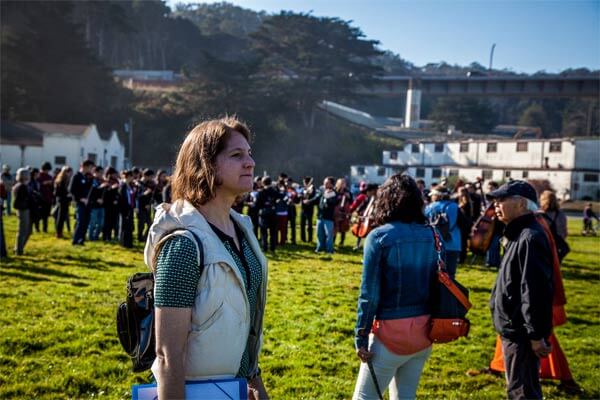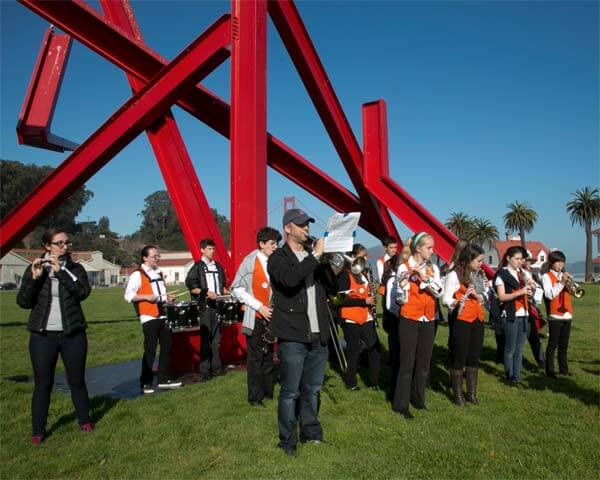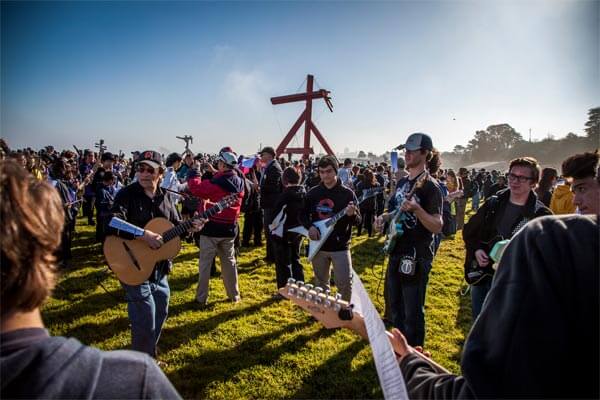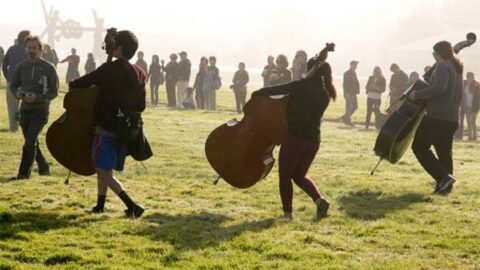 It is truly difficult to objectively review a work like Lisa Bielawa’s Crissy Broadcast. The hour-long piece, which received three performances over the weekend of October 26 in San Francisco’s own Crissy Field, was preceded by months of hype, interviews and panel discussion in the Bay Area and beyond. And why shouldn’t it? Any project that can successfully wrangle together a musical community of more than 800 performers, ranging from amateurs to middle school bands to seasoned new music professionals, is surely worthy of more than just a newspaper blurb and a page of program notes. Indeed, the hype preceding the weekend of Crissy Broadcast felt more reminiscent of a movie premiere than a music premiere – a luxury that new music is rarely afforded. The result was a feeling of unusual anticipation in the San Francisco air – and with it, naturally, high expectations.
It is truly difficult to objectively review a work like Lisa Bielawa’s Crissy Broadcast. The hour-long piece, which received three performances over the weekend of October 26 in San Francisco’s own Crissy Field, was preceded by months of hype, interviews and panel discussion in the Bay Area and beyond. And why shouldn’t it? Any project that can successfully wrangle together a musical community of more than 800 performers, ranging from amateurs to middle school bands to seasoned new music professionals, is surely worthy of more than just a newspaper blurb and a page of program notes. Indeed, the hype preceding the weekend of Crissy Broadcast felt more reminiscent of a movie premiere than a music premiere – a luxury that new music is rarely afforded. The result was a feeling of unusual anticipation in the San Francisco air – and with it, naturally, high expectations.

For those who haven’t been, Crissy Field is an overwhelmingly large space, and as I trekked towards the crowd in the middle at 4 pm on that Saturday afternoon I was stunned by how small it seemed in comparison to the landscape. The musicians began arranged in a tight cluster of patches, allowing the audience to weave through them and mingle. For many it was equal parts concert and social gathering – a combination of new music comrades, supportive moms and dads, and curious passersby, all quietly observing, discussing, waiting.
A foghorn echoed across the bay as zero hour approached, and a note sounded and began to spread infectiously across the patch of musicians. As the tone shimmered through the air and blossomed into a major third, a brief but magical duet ensued between the performers and environment as the foghorn sounded again across the bay, providing the relative minor to the humming major of Crissy. (I can only imagine that Bielawa spent enough time in the space to orchestrate such a lovely coincidence!)

From there, new musical shapes began to erupt among the ensembles. Percussion orchestras pulsed hairpin, Noh-like accelerandi, wind bands cascaded upward in slithering scales, and a chorus (presumably the San Francisco Girls Chorus, of whom Bielawa is the artistic director) sang haunting, wordless harmonies. Within a few minutes, the tangled thicket of musicians began to separate and drift ever outward, leaving the lone listener to freely navigate the terrain of Crissy in search of musical meaning.
It’s tough to examine the sonic makeup of Crissy Broadcast with objectivity because it is a piece based so purely on the subjective listener’s experience. There are as many different aural routes as there are heads in the crowd, and with such a staggering amount of musical and spatial information, the unfortunate reality is that something is going to be missed. I found the experience simultaneously intriguing and frustrating – as I wandered from group to group to make musical sense of what was going on, I couldn’t help but feel there was always something just as interesting across the field that was simply getting lost in the breeze. Yet despite my frustrations I found something beautifully poignant about this fact as well, and reflective of a larger reality of modern life. Kudos to Bielawa for allowing enough room in her piece for almost-profound epiphanies on the part of her listeners.

Despite the conceptual difficulties of listening to Crissy Broacast, Bielawa was extremely savvy in her execution of musical ideas. As one wandered among the groups, catching traces of sound in the wind, there were returning ideas that echoed and played off each other. My personal favorite moment (sans foghorn) was at the half-hour mark: I found myself in dead center of the field, the ensembles divided evenly on either side in antiphonal choirs, passing the same chord back and forth across the vast geography of the space. Moments of elision like this were laced throughout the work, from ensemble material to echo games played among a string of wind players along the path bisecting the field.
The musical palette was as diverse as the players involved (which, by the way, ranged from Chinese orchestras to electric guitars, symphonies to alphorns); there were moments of clangorous Ivesian cacophony, Cagean coincidence, and Ligeti-esque sonic specters. Indeed, the work was so loaded with possibility that, as a friend of mine noted, an hour almost didn’t feel like enough. It was more than fortunate that the weekend offered three separate performances!

As the hour rounded off, the ensembles slowly retreated to the perimeter of the field and went their separate ways. There was a smattering of applause on either end, but in many ways the lack of a finale seemed fitting for a piece so purposefully intent on blurring the line between art and life, artist and community. I was left intrigued, captivated, and in possession of more questions than answers. Who is a work like Crissy Broadcast art really for? The performers? The audience? Both? And how is success measured: By the tightness of the musical form? By the satisfaction of the experience? By the level of community engagement? Or by the slew of “teachable moments” the project raises in the path from conception to performance? Regardless of these, the work created an experience that reached beyond the boundaries of classical music, and undoubtedly touched lives along the way.
























